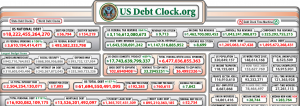The National Debt Climbs Despite Shrinking Deficits
< < Go Back
While deficits have shrunk in recent years, the national debt remains at record high levels and trillion-dollar deficits are projected to return within a decade. Significant debt reduction will be required to put the budget on a more sustainable long-term path, enacting sequester relief or other tax and spending initiatives will require offsetting spending cuts or revenue increases to avoid making the debt situation even worse.
With Congress’ need to reduce the long-term debt and pay for costly policy changes, the Committee for a Responsible Federal Budget (CRFB) has compiled a number of policy options that can produce savings through changes to health care spending, tax revenues and spending on other mandatory (non-health and non-Social Security) programs.
Consider these potential 2016-2025 savings estimates:
– For Health Savings Options, total savings will be $1.5-$1.6 trillion. An increasing means testing of Medicare can save about $155 billion. Reducing payments to Medicare providers can save another $330 billion. Savings from modifying cost-sharing is around $190-$290 billion. Raising Medicare age, while protecting low-income individuals can save $30 billion. Save on prescription drugs will be $425-$440 billion. Savings from reducing Medicaid payments, reforming medical malpractice suits and reforming payment system are $200 billion, $70 billion, $135 billion, separately.
– Revenue options can save $10.7-$10.9 trillion in total. Basic tax reforms can save $7.29-$7.3 trillion. Reforming State and local bond exclusion can save $190 billion. Savings from reforming accelerated depreciation is $1570 billion. Reforming various workers’ benefits can save another $1.3-$1.4 trillion. And other options such as elimination exclusion for income earned abroad, repealing exclusion for various Veterans’ benefits, eliminating select oil and gas preferences can save $365 billion.
– For other mandatory savings options, total savings is $1.2 trillion. It includes cross-cutting savings, reducing agricultural subsidies, altering Federal retirement benefits, etc.
More From NCPA:




